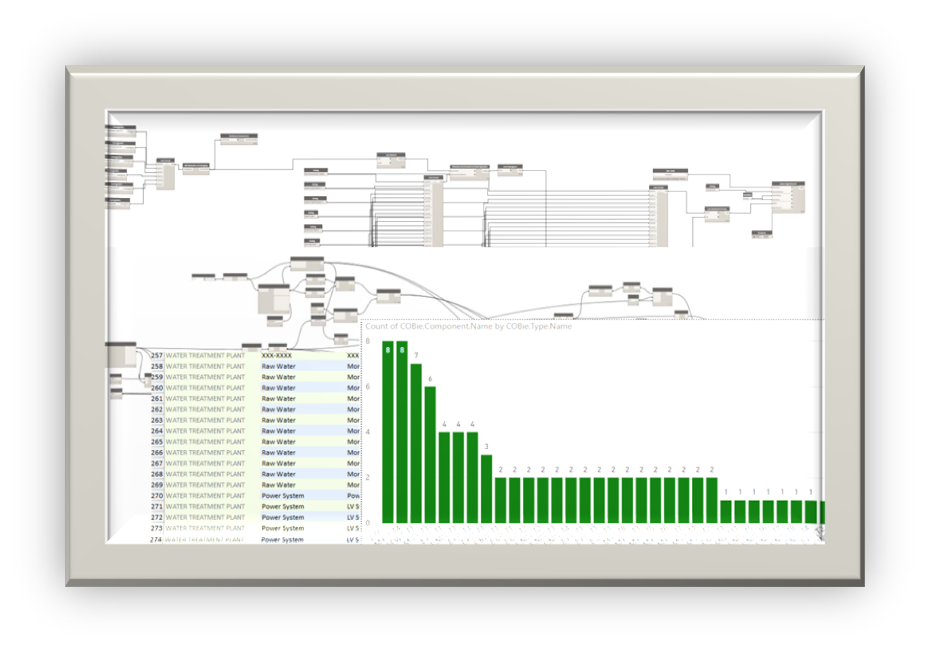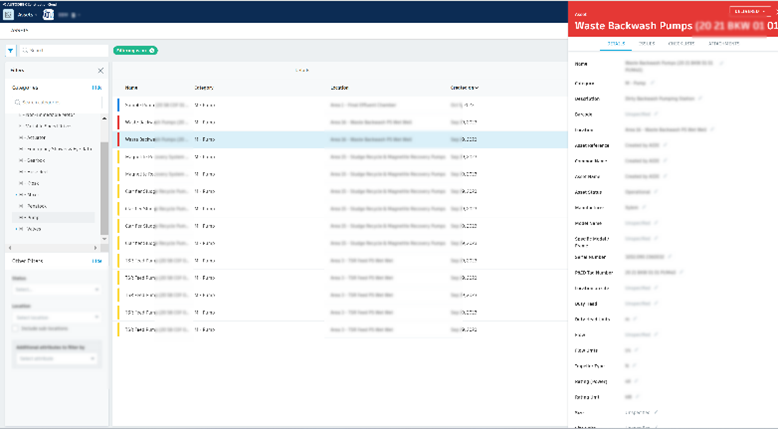Understanding the ins and outs can be challenging in the complex digital project delivery and asset information management world, especially for those not well-versed in COBie (Construction Operations Building Information Exchange), IFC (Industry Foundation Classes) or the relevant standards.
To remind you – COBie and IFC are two fundamental formats for information exchange in a Building Information Modelling (BIM) delivery process. COBie focuses on efficiently transferring non-graphical asset information for facility management procedures, and IFC provides a non-proprietary open-source schema for sharing data between various software platforms. They support interoperability while enabling information transfer and collaboration throughout the project lifecycle.
Open-source data structures and standards are essential for changing the construction industry, especially in a critical sector like water.
However, although clients are eager to reap the benefits of BIM, they often find themselves at a crossroads. The issue is that many water sector clients use systems that aren’t configured to utilise IFC or COBie data directly yet. Only time and standardised delivery will allow them to define precisely how they want to receive information.
This means that while we need to stick to industry standards such as the ISO19650 series, we also need to ensure that the information we hand over at the end of a project can be easily used with the systems our clients currently have in place.
The Path to Progress
ISO19650 guides our digital processes. The series of standards is like a global playbook for considering digital project delivery correctly, from start to finish, on any construction project. They are all about ensuring everyone involved can work together smoothly and efficiently without wasting resources while managing project costs and minimising the toll on our planet. It’s not much of a challenge ….
They have been developed to help the construction sector get the most out of BIM, enabling digital delivery on projects to run better for everyone involved. It provides the framework for information management, emphasising collaboration and efficient data exchange throughout the project lifecycle. But it’s not a rigid script; we like to flex it to match our clients’ digital journeys. We have placed a lot of emphasis on its requirements over the past years. This emphasis has become more imperative recently with the introduction of an Irish mandate to adopt ISO19650 as the delivery mechanism for projects on the CWMF (Capital Works Management Framework) since January ’24.
As we see it, the task is balancing between adhering to industry standards and ensuring our clients fully utilise our data without rushing to overhaul their existing systems before they understand their specific requirements.
At Glanua, we go beyond the checklist mentality. Regarding asset management, we start by standing back and assessing what the end needs to look like. This can often be a set of project objectives or a simple question – “what level of information can we capture at each phase of the project to align with our client’s handover requirements?” or “How can we provide the information which will allow our business functions to make the next right decision efficiently to progress the project. We must understand who will deliver the information at each stage, how it will be produced, captured, structured, and stored and finally, who needs to use it next.
Our Starting Perspective
Starting in the design phase and extending through construction, our process focuses on the early definition of asset information requirements, agreeing on when, how and who is responsible for each piece of information. The responses to these queries are detailed in our Project BIM execution plan (BEP) and, specifically, the Responsibility Matrix issued to all stakeholders during the project’s initial phase.
These two documents are required when delivering a BIM project. In Glanua, however, they are not just about ticking boxes; they are about setting a plan in place that will ultimately tell the story of each asset’s project journey, capturing – material information, serial numbers, delivery dates, installation dates and on-site conditions, to name but a few. The key to efficiency is understanding when the information is needed (internally or externally), and the earliest point in the project is that it will answer a specific question, either for one of our teams or our client.
Why is any of this important to us, you ask? We are a conscientious group in Glanua and understand our ESG (Environmental, Social and Governance) requirements. We know that we must become more efficient in everything we do daily. Focusing on minor modifications can lead to significant change, leading us toward a more sustainable future. We are also obsessed with exceeding our client’s expectations while we work collaboratively on their journey.
Our Client’s Starting Perspective
A one-off specific type of handover on a one-off project will not help our clients or the industry to transition digitally. The water sector and our clients need a method for taking their project operation & maintenance, carbon, requirements, etc. and developing a process that can be repeated easily every time they work with us to deliver the same data structure consistently.
As they say, consistency is the key to efficiency. Our output aims to provide the evidence they need to define standardised deliverables across their supply chain. They need to see it structured in a relatable and easily validated manner.
Our clients are no different from where we were when we commenced our BIM journey, navigating buzzwords and acronyms and searching for something that makes sense. In our opinion, for adoption to take hold, you must start to see benefits early. What is the point if we don’t see benefits from delivering projects digitally? The advantages of using digital delivery processes must become apparent early to justify the transition and ensure its success.
For digital delivery to look like progress in their organisations, they may need to ignore the noise around BIM and digital delivery initially. Instead, they should concentrate on small wins that matter most to their organisation. For example – can our asset register be populated from the model? Can we see our maintainable asset list on the CDE? Can we know each asset’s O&M and Material requirements in one location? Can you show us the percentage of asset data that has been captured? This is what we call consistency, and the outputs are relatable. Once our clients know what they are getting, and it becomes tangible and relatable, they instantly see the benefits of the digital approach.
Of course, they can and should ask us questions like: Can we deliver to ISO19650? Can we do COBie? Do we exchange information in IFC? The answer to all three is a resounding yes. Asking these questions is not the issue; it is getting the correct information in the proper format so you can use it. If you can’t use it immediately, we have wasted valuable time and energy.
Our solution is to make delivery transparent and ensure we are set and working to standard delivery methodology at all times in the most efficient collaborative manner alongside our clients. Our data is always available to them and is structured to match their asset management system. The progress of asset data collection is always visible on our CDE and is up for discussion.
Keep the Process Simple
Our toolkit must become the conductor directing our asset data structure configuration from the design phase forward. This orchestrated process finds its temporary home in our Common Data Environment (CDE), ensuring accessibility and integrity for all stakeholders from commencement to completion.
Our approach involves holistically understanding where our clients are on their digital journey and developing a delivery process that seamlessly fits into their existing system. The water sector is in full flow with a constant volume of projects, which vary significantly in complexity and project value. We must understand what will help a client’s organisation the most in their gradual transition to fully digitised project delivery.
Fortunately for our clients, we know exactly how to maximise the capability of our standard suite of software solutions, which, for this insight, are Autodesk Revit, Autodesk Plant 3D, Dynamo, Autodesk BIM 360, and Microsoft Power BI. These tools allow us to fine-tune asset data management and deliver information tailored to our client’s needs.
Revit and Plant 3D are our primary design tools for producing drawings and 3D models. They are also where we commence building our asset database.
Dynamo allows us to easily extract data for checking and verification, ensuring the relevant data is available from the outset.

BIM 360 allows us to centralise data collection. The platform’s asset module and mobile application enable us to collect and, more importantly, allocate the collection of more site-specific equipment data from the field across our project delivery team. Essentially, anyone in our team with a mobile phone can become part of the data collection chain. The BIM 360 mobile app becomes our greatest ally, allowing us to build a robust dataset by recording intricate details.
It’s not just about standards compliance; it’s about creating a comprehensive asset database that traces each asset’s journey throughout the project. Linking an asset to its tag number and commissioning sheet, recording its serial number, and attaching an image from the site are vital pieces of information that help complete our project requirements.

Image 2 – Structure, Evaluate and Capture asset data within the CDE.
Power BI is a champion in our commitment to data-driven decision-making. It’s fundamental to quantifying the progress of asset data capture, ensuring our data aligns with our client requirements. It allows us to merge information from various sources into a unified view, providing a holistic picture of model data structure, CDE data and onsite capture. This can then be reported to our client as progress toward completion.
All companies must consider information management and data capture as a commitment to accuracy, completeness, and verification.
Our step-by-step approach involves defining asset information requirements, assigning responsibility, structuring attributes within the CDE, and utilising a CDE platform with a mobile app for on-site data collection. Power BI becomes the discerning critic, ensuring consistency and alignment with established asset information schema. The benefits to our clients are assurance that they see the result during the process, removal of ambiguity, and easy verification of their data.
Our philosophy is designed to deliver efficiency and collaboration, streamline asset management, and ensure compliance with standards. It’s about improving data awareness and consistency for informed decision-making, ensuring our projects not only meet industry regulations but always aim to exceed client expectations. We acknowledge that adopting digital delivery requires a culture change and upskilling; as such, we continually provide training to our employees and clients. If you would like to find out more, please get in touch!
Author: Jonathan Grimes – BIM & Digital Construction Lead at Glanua

Throughout his 15+ year career in the construction industry, Jonathan has consistently aimed to strengthen his professional journey with a robust academic foundation. Acquiring a PGdip. in Applied Building Information Modelling & Management from the Technical University Dublin, a BSc. in Civil Engineering & Project Management from the Technical University of the Shannon, and a Cert Engineering in Civil Engineering from Limerick Institute of Technology, his focus has centered on Digital Project Delivery and BIM since 2012.
As a certified BIM Manager by RICS and an Autodesk certified professional, Jonathan sees these credentials as essential in staying abreast of evolving industry standards and practices within this dynamic landscape.
His experience has translated seamlessly into his current role as Digital Lead within Glanua’s technical department. Here, he actively contributes to driving digital project delivery and BIM, aligning technological advancements with project objectives. These competencies have led him to contribute significantly to several flagship projects and engage in influential focus groups such as the BIM for Water task group and CITA regional events.
Jonathan’s unwavering belief lies in the imperative nature of digital adoption and collaborative delivery to lead the construction sector into a more sustainable future. He is convinced that achieving this goal requires leveraging digital processes, technology, and expertise to foster innovation, streamline efficiency, and maintain quality across a diverse project portfolio and client requirements.
